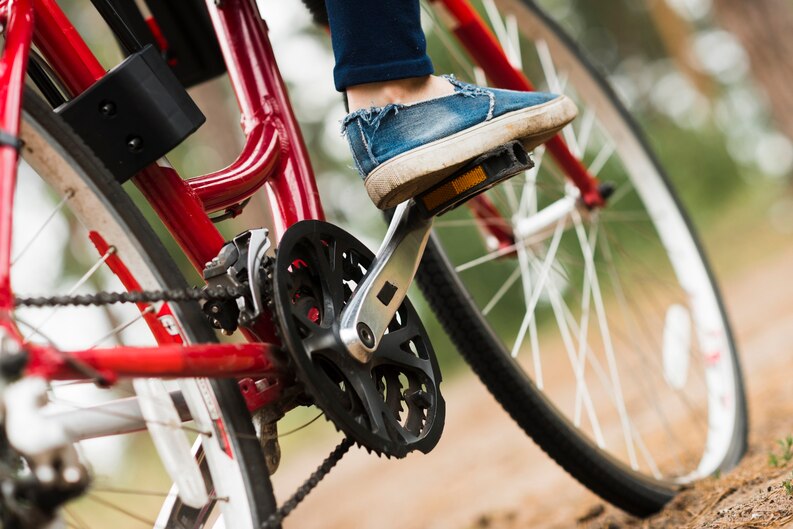I’ve always found clipless pedals interesting, to say at least. The idea of being securely connected to my bike while enjoying the freedom to pedal efficiently and confidently is an enticing prospect. Let’s discuss the benefits of using clipless pedals, and compare them to other pedal types.

The Advantages of Clipless Pedals
Clipless pedals offer several benefits that enhance the cycling experience for non-professional riders
- Improved Efficiency: One of the key advantages of clipless pedals is their ability to allow for a smoother and more efficient pedal stroke. By securing your feet to the pedals, clipless systems enable you to utilize both the downstroke and upstroke effectively, maximizing power transfer to the bike.
- Enhanced Control and Stability: The secure connection between your shoes and clipless pedals provides a sense of stability and control, particularly during challenging terrains and technical sections. This feature can be especially beneficial for mountain biking enthusiasts.
- Increased Confidence: With clipless pedals, you can ride with confidence, knowing that your feet won’t slip off the pedals unexpectedly. This advantage can be particularly valuable when navigating steep climbs, sharp turns, or fast descents.
Clipless Pedals vs. Other Pedal Types
- Flat Pedals: Flat pedals are commonly used by beginners and riders who prefer the freedom to quickly and easily disengage their feet from the pedals. They provide a stable platform and are suitable for various cycling disciplines. However, clipless pedals offer superior power transfer, efficiency, and control, making them a preferred choice for many cyclists, especially when it comes to road cycling and mountain biking.
- Toe Clips: Toe clips, also known as cage pedals, were a popular option in the past. However, clipless pedals have largely replaced them due to their superior functionality and safety features. Clipless systems eliminate the risk of feet becoming trapped during sudden stops or accidents, providing a safer and more reliable solution.
From My Perspective
Transitioning to clipless pedals can be an exciting yet challenging process for non-professional cyclists. When I made the switch, there was an adjustment period where I needed to familiarize myself with engaging and disengaging my shoes from the pedals. Initially, it felt a bit awkward, but with practice, it became second nature. The learning curve involved patience and perseverance, but the benefits I experienced made it worthwhile.
Different Clipless Pedal Systems
Various clipless pedal systems exist, with Shimano SPD pedals being the most popular option for non-professional cyclists. Shimano SPD pedals are renowned for their durability, ease of use, and compatibility with mountain biking shoes.
Tips for Choosing the Right Clipless Pedals and Shoes
For beginners venturing into the world of clipless pedals, here are a few tips to consider:
- Select the pedal system that aligns with your cycling discipline and preferences. For road cycling, three-bolt cleat systems are common, while two-bolt cleat systems are popular for mountain biking and commuting.
- Choose shoes that provide a comfortable fit, adequate stiffness for efficient power transfer, and compatibility with your chosen pedal system. It’s advisable to try on different shoes to find the best fit for your feet.
- Start with pedals that offer easy engagement and disengagement, such as Shimano SPD pedals, to ease the learning process. Gradually, you can transition to more advanced pedal systems as your confidence and skills improve.
Addressing Common Misconceptions and Concerns
- Fear of Not Being Able to Unclip: Many beginners worry about being unable to unclip from clipless pedals and falling over. However, clipless systems are designed with adjustable release tension, allowing riders to find a comfortable setting that suits their needs. Practice in a safe environment and gradually increase the tension until you find the right balance between security and ease of disengagement.
- Efficiency Myth: There is a common belief that clipless pedals significantly enhance pedaling efficiency. While clipless pedals do provide some efficiency benefits, the notion of “pedaling circles” is a misconception. Professional cyclists mainly rely on the downstroke for power generation, rather than actively pulling up on the pedals.
Conclusion
Clipless pedals offer numerous advantages for non-professional cyclists, including improved efficiency, control, stability, and confidence. While there is a learning curve associated with using clipless pedals, the benefits outweigh the initial challenges. By choosing the right pedal system and shoes, non-professional cyclists can enhance their cycling experience and take their riding to new heights.
Whether you’re a road cyclist or an off-road enthusiast, clipless pedals can be a game-changer, providing you with a more enjoyable and efficient ride.

